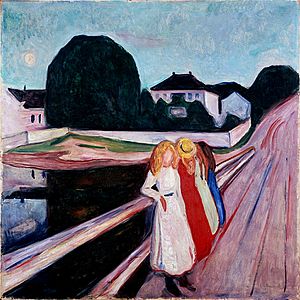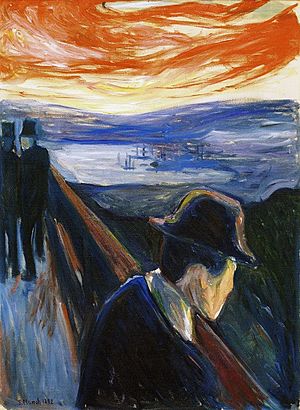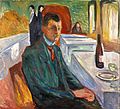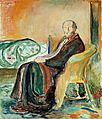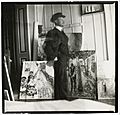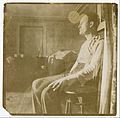Edvard Munch facts for kids
Quick facts for kids
Edvard Munch
|
|
|---|---|
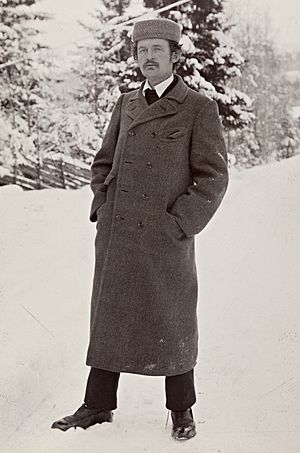
Munch in an undated photo
|
|
| Born | 12 December 1863 Ådalsbruk, Løten, Norway
|
| Died | 23 January 1944 (aged 80) |
| Nationality | Norwegian |
| Known for | Painting and graphic artist |
|
Notable work
|
|
| Movement | Expressionism, Symbolism |
Edvard Munch (born December 12, 1863 – died January 23, 1944) was a famous Norwegian painter and printmaker. He was born in Adalsbruk, Norway. Munch was an expressionist artist. This means he focused on showing strong feelings and ideas in his art, rather than just what things looked like. He painted many artworks, and is especially known for showing emotions like fear. His unique style greatly influenced the art movement called Expressionism in the 20th century.
During his life, Edvard Munch became very successful. He was famous not only in Norway but also in other countries. His paintings were highly valued and sold for good prices. The National Gallery (Norway) spent a lot of money to buy his artworks. He also painted large pictures called murals in the main hall (called the aula) of Norway's main university.
Contents
Famous Paintings by Edvard Munch

One of Munch's most famous paintings is The Scream. He painted it in 1893, and it was first called Despair. This painting is one of the most recognized images in the world. It is part of a group of artworks called The Frieze of Life. In this series, Munch explored big ideas like life, love, fear, death, and sadness. Like many of his works, he made several versions of The Scream.
Many people believe The Scream shows the feelings of worry and anxiety that people can experience in modern life. One version of The Scream was stolen from the Munch Museum in Oslo, Norway, in 2004. Luckily, it was found in 2006, along with another stolen painting called Madonna.
The themes from The Frieze of Life appear often in Munch's other works. You can see these ideas in paintings such as The Sick Child (1886). This painting is a portrait of his sister Sophie, who had passed away. Other examples include Ashes (1894) and Four Girls on the Bridge (1905). In Four Girls on the Bridge, the people look tired or weak. Their faces are hard to see or have no features at all. Dark shapes of trees and houses seem to hang over them. Munch often showed women in his art as either fragile and suffering, or as powerful and mysterious figures.
About Edvard Munch's Life
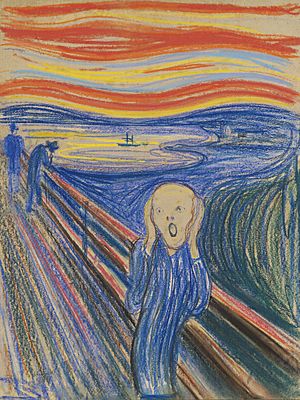
Edvard Munch was born on December 12, 1863. He was one of five children. When Munch was young, his parents, a brother, and his favorite sister all passed away. These sad events likely influenced the serious and sometimes gloomy mood in many of his paintings.
Munch became very interested in art when he was about thirteen years old. His first paintings were of simple things like medicine bottles. Later, he started using oil paints.
In 1879, he went to a technical college. There, he learned how to draw with perspective, which makes things look three-dimensional. The next year, in 1880, he decided to become a full-time painter. He then studied at the Royal School of Art and Design. This is where he learned about sculpting and painting things in a realistic way. It was here that he painted his first important portraits, including one of himself and one of his father.
In 1885, Munch traveled to Paris, France. His art began to show the influence of French painters. First, he was inspired by Impressionists, who focused on light and color. Then, he was influenced by Post-Impressionists and the Art Nouveau style, which used flowing lines and natural forms.
In 1892, Munch had an art show in Berlin, Germany, which caused some debate. He also became friends with several writers, including the famous Norwegian playwright Henrik Ibsen. Munch even designed the backgrounds for some of Ibsen's plays.
Between 1892 and 1908, Munch spent a lot of time in Paris and Berlin. During this period, he became well-known for his prints, such as etchings, lithographs, and woodcuts.
After 1910, Munch moved back to Norway. He lived and painted there until he passed away. In his later paintings, Munch showed more interest in nature. His artwork became more colorful and less serious than before.
Munch was often sick during his life. Some scientists think he might have had bipolar disorder, which affects a person's mood.
Edvard Munch died in Ekely, near Oslo, on January 23, 1944. He left many of his artworks to the city of Oslo. To honor him, the city built the Munch Museum. This museum has the largest collection of his works in the world. Some of his paintings are also displayed at The National Gallery, which is also in Oslo.
Munch's Legacy
When Edvard Munch passed away, he gave all his remaining artworks to the city of Oslo. The city then built the Munch Museum in a place called Tøyen, which opened in 1963. This museum holds an amazing collection of his art. It has about 1,100 paintings, 4,500 drawings, and 18,000 prints. This is the biggest collection of his works anywhere in the world. The Munch Museum also manages the rights to his art, making sure his work is used correctly.
Sadly, some of Munch's paintings have been stolen over the years. One version of The Scream was stolen from the National Gallery in 1994. In 2004, another version of The Scream and a painting called Madonna were stolen from the Munch Museum in a bold daytime robbery. Luckily, all these paintings were eventually found. However, the ones stolen in 2004 were badly damaged. They have since been carefully fixed and are now back on display. In 2005, three more Munch artworks were stolen from a hotel called Refsnes Gods. They were quickly found, but one was damaged during the theft.
Munch's artworks are very valuable. In October 2006, a colored woodcut print called Two people. The lonely was sold for a record price for his prints. It went for 8.1 million NOK (about 1.27 million USD) at an auction in Oslo. This was also the highest price ever paid for an artwork at an auction in Norway at that time. On November 3, 2008, his painting Vampire set a new record for his paintings. It sold for over 38 million USD at an auction in New York.
Edvard Munch's picture is even on the Norwegian 1,000 Kroner banknote. The banknote also features images inspired by his art.
Fun Facts About Edvard Munch
- After the Cultural Revolution ended in People's Republic of China, Munch was the first Western artist to have his paintings shown at the National Gallery in Beijing.
- Some art historians think that the bright red sky in the background of The Scream might be inspired by the very intense sunsets seen around the world after the 1883 eruption of the Indonesian volcano Krakatoa.
- The band Solefald wrote a song about him on their 2003 album In Harmonia Universali. The song is called "Christiania (Edvard Munch Commemoration)".
- Google celebrated his birthday in 2006 by changing their main page logo to a special design that looked like his famous painting The Scream.
- In an episode of "The Simpsons," the bullies in the town steal The Scream as a funny side joke.
Related pages
Images for kids
-
The Scream (1893), National Gallery, Oslo
See also
 In Spanish: Edvard Munch para niños
In Spanish: Edvard Munch para niños



